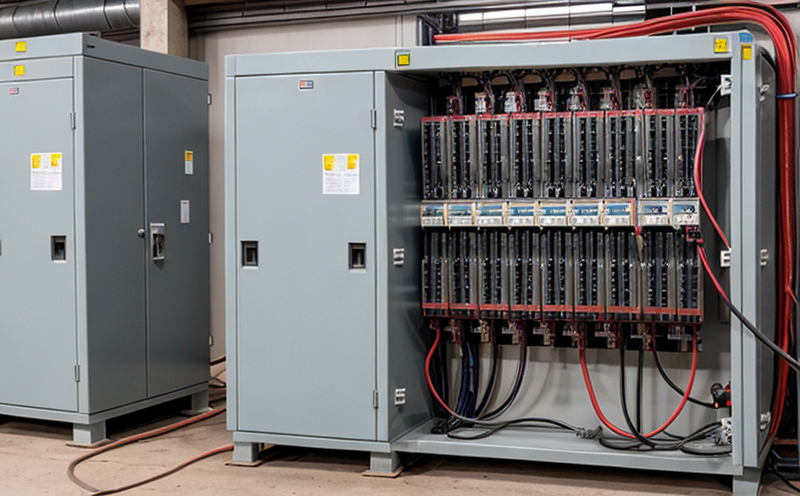IEC 60270 Partial Discharge Testing of Transformer and Switchgear Insulation
The IEC 60270 standard is a cornerstone in ensuring the reliability, safety, and longevity of transformer and switchgear insulation systems. This testing method identifies potential weak points or defects within the insulating materials by detecting partial discharges (PD), which can be indicative of early-stage degradation or impending failure.
Partial discharge occurs when electrical energy does not flow uniformly through a conductor but instead takes an alternate path, often through air gaps or voids in insulation. These gaps act as capacitors that store and release small amounts of electrical charge, leading to the emission of electromagnetic radiation and localized heating. The IEC 60270 method is designed to detect these PD events with high sensitivity, allowing for timely maintenance actions before the defects escalate into larger problems.
The testing process involves applying a voltage higher than the normal operating voltage across the insulating material under test (IUT). This stress can induce partial discharges if there are any flaws in the insulation. The test setup includes specialized equipment capable of capturing and analyzing these emissions, such as high-frequency current transformers (HFCT), coupling capacitors, and measuring instruments like spectrum analyzers.
Proper specimen preparation is crucial for accurate testing results. This involves cleaning the IUT to remove any contaminants that could interfere with PD detection, ensuring that all connections are secure and free from loose elements, and applying the correct test voltage according to the standard specifications. The test voltage should be applied gradually to prevent sudden failures due to overvoltage.
The testing setup typically consists of a high-voltage generator, coupling capacitors, HFCTs, and spectrum analyzers. These components work together to capture PD signals, which are then analyzed for frequency content and amplitude. High-frequency currents induced by the PD events are detected using HFCTs and measured with precision instruments.
The results of IEC 60270 testing provide critical insights into the condition of transformer and switchgear insulation systems. These tests can help identify areas that require immediate attention or routine maintenance, thereby preventing costly downtime and potential safety hazards. By adhering to this standard, manufacturers and operators ensure compliance with international best practices for electrical equipment.
Understanding the importance of partial discharge testing is essential for quality managers and compliance officers involved in the lifecycle management of transformers and switchgear. R&D engineers can use these insights to improve design and manufacturing processes. For procurement teams, ensuring that suppliers meet this standard guarantees the reliability and safety of the components used in critical infrastructure.
The IEC 60270 standard is widely recognized for its robustness and reliability in detecting PD events within insulating materials. By implementing this testing method, organizations can significantly enhance their ability to predict and prevent failures, thereby improving overall system performance and reducing maintenance costs.
Applied Standards
The IEC 60270 standard is the most widely accepted international guideline for partial discharge testing of transformer and switchgear insulating systems. This standard defines the test methods, acceptance criteria, and reporting requirements necessary to ensure accurate and reliable PD detection.
- IEC 60270 provides a comprehensive framework for testing insulating materials in transformers and switchgear.
- The standard specifies voltage levels, duration of tests, and measurement techniques to be used during partial discharge testing.
- It also outlines the acceptance criteria that must be met by the IUT to pass the test successfully.
Adherence to this standard ensures consistency and comparability in results across different laboratories and regions. This is particularly important for manufacturers, operators, and regulatory bodies who rely on these tests as part of their quality assurance processes.
Quality and Reliability Assurance
- Early Detection: IEC 60270 testing allows for the early detection of insulation defects that could lead to catastrophic failures. By identifying these issues in advance, organizations can implement corrective actions before they escalate into more serious problems.
- Predictive Maintenance: The results from this testing method enable predictive maintenance strategies, which help optimize equipment performance and extend service life. This approach minimizes unnecessary downtime and reduces overall operational costs.
The IEC 60270 standard plays a pivotal role in maintaining the integrity of electrical insulating materials used in transformers and switchgear. By providing accurate and reliable data on PD events, this testing method supports continuous quality improvement efforts within manufacturing processes. This ensures that all components meet strict safety and performance standards.
Compliance with IEC 60270 also enhances the reputation of manufacturers and operators by demonstrating a commitment to excellence in product design and operational practices. In an increasingly competitive market, this level of reliability can be a significant differentiator for businesses seeking to gain market share and customer trust.
Customer Impact and Satisfaction
The IEC 60270 standard directly impacts the satisfaction and trust customers have in electrical equipment. By implementing this testing method, manufacturers ensure that their products meet high standards of quality and reliability, which is crucial for customer confidence.
- Enhanced Safety: Detecting insulation defects early through partial discharge testing significantly reduces the risk of accidents and injuries associated with faulty transformers and switchgear. This increased safety enhances customer peace of mind and satisfaction.
- Predictable Performance: Predictive maintenance strategies enabled by IEC 60270 testing help maintain consistent performance levels, which is essential for critical infrastructure operations. Reliable equipment ensures business continuity and operational efficiency.
Customers value transparency in the manufacturing process and the assurance that their equipment undergoes rigorous quality control measures. By adhering to international standards like IEC 60270, manufacturers provide this transparency, leading to higher customer satisfaction and loyalty.





